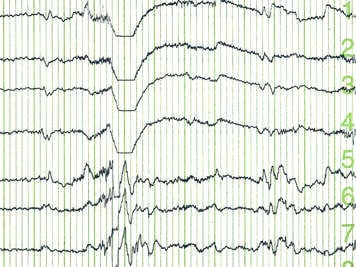What is an electroencephalogram (EEG)?

Cells in the brain use low levels of electricity to communicate with each other. An electroencephalogram (EEG) measures this electrical activity over time. The brain's electrical activity shows up as wavy lines on a computer monitor. Health-care providers read the wavy lines to find out how well the brain is working and tell where and when seizures start.
Reasons to have an EEG
Health-care providers use the EEG to locate problems in the brain. For example, an EEG can show where seizures start. The electrical pattern changes when there is a problem. The change in pattern shows up as a change in the wavy lines on the computer screen. This shows where in the brain the problem is. The health-care provider can then decide on the best treatment.
How to get your child ready for an EEG
Wash your child's hair before you bring them to the hospital. You should check for head lice when you wash your child's hair. Look for crawling lice or nits (small white or brown specs) firmly attached to the hair near the scalp when you part your child’s hair. If there are any signs of lice, please tell the nurse at the lab. Please do not use conditioner or gel on your child's hair.
Sedation
Your child will need to lie still for the EEG test and, in some cases, fall asleep during part of the test. If they cannot do this, then they may need to take a medicine to help them sleep. A natural sleep enhancer known as melatonin is often used. Sometimes, a sedative is used if it is very difficult for your child to lie still or fall sleep. A sedative is a medicine that will calm your child so they can lie still. Commonly used sedatives for EEG include chloral hydrate, melatonin and dexmedetomidine.
If your child needs sedation, they will need to fast before the procedure. Follow the guidelines for fasting before sedation in the article What are the fasting guidelines for your child before surgery and ask your child’s health-care team if you are unsure when to stop your child from eating and drinking.
During an EEG
A routine EEG takes about an hour. It does not hurt.
EEG tests are usually done at a hospital. They are done by an EEG technologist, a person who is specially trained. Usually, children lie on a bed during an EEG. Sometimes, children sit down during an EEG. Parents are allowed to stay with their child while the test is done.
Your child's head will be measured and marked with a wax pencil so that the EEG technologist knows where to put the small metal circles called electrodes. The electrodes are sensors that detect the electrical activity of the brain. The marked areas on your child's head will be cleaned with a gel, which is a thick soap. Then electrodes will be put on your child's head with cream and gauze. The electrodes are hooked up to the computer.
The computer records the patterns of electricity of your child's brain. The EEG machine makes a continuous record of your child's brain activity, which can be seen on a computer screen.
During the test, the technologist may ask your child to:
- breathe deeply for three minutes
- open and close their eyes
- watch a flashing bright light for a few minutes
These exercises are done to stimulate certain types of brain activity. This can help health-care providers figure out what might cause a seizure. As this brain activity changes, so do the electrical patterns. How these patterns change during the different activities can help health-care providers find out more about how the brain works.
Asleep and awake
Your child may have the test while they are asleep and again while they are awake. This may show the differences in the brain when your child is awake and asleep. Some children may need to stay awake prior to the EEG so that they are more likely to fall asleep during the test.
Side effects from EEG
If your child did not have a sedative, they will have no side effects or problems from the EEG.
If your child had a sedative, they might be sleepy, grumpy and unsteady for four to six hours. If your child has received sedation, you will be given instructions about drinking, eating and return to regular activity.
Your child's hair may be a little sticky from the cream. You can wash out the cream with shampoo.